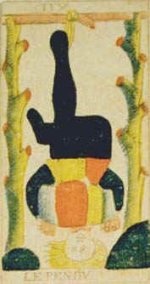Lunaeyes said:
I was given this deck by a friend a few months ago. The hanged man card differs from my other decks. The nonextended leg is behind the hanging one . How does this affect a reading if at all?
You're going to find many such changes in different decks--depending on which deck is their inspiration (Waite, Crowley or Marseille), depending on artist inspiration and/or creator interpetation. The little details usually don't change the meaning as much as the bigger details (for example, the meaning of the Hanged Man will probably remain "A sacrifice, a time of suspension..." no matter how that leg is positioned. However, there might well be a difference in the reading if the Devil card you're using depicts a goat-footed Dionysis dancing about a green glade as compared to a horned demon in a fiery hell, no?).
Little details matter if you're into them. For example, what is our hanged-man hung from? In Waite, it was important that he be hung from a "tau" cross--that is, a "T" shaped cross because it relates to the hebrew letter "Tau"--in others you'll see him suspended from a bar instead.
Some would say, further, that whether he hangs from right leg or left leg matters, as it is the "free" leg which will "step out" from suspension. If he hangs from the right leg, then he will step out with his left--the unconscious. If he hangs from his left, then he will step out with his right--the conscious mind. One might argue that hanging from the left, therefore, is more "correct" because the Hanged Man, a willing sacrifice, is drifting in the in unconscious (left leg) and needs to leave this state, once transformed, by conscious will.
There is also the question of whether the hands are tied or not--if tied, then arms and head form an inverted triangle and the folded leg becomes a cross, giving one the inverted symbol for Sulfur (a triangle atop a cross). Sulfur was one of the three, basic alchemical components for transformation (salt and mercury were the other two)--it is a fiery component subverted, one might say, by the power of water which dominates this card. (I believe, by the way, that Crowley went for a "right-side-up sulfur by making the folded leg form the triangle, and spreading the arms of the man to create the cross below).
So. How does this answer your question? The answer, in short, of whether it makes a difference depends entirely on how deeply you want to get into the nitty-gritty bits and pieces of the card. In a lot of cases, the artist/creator has gone to great lengths with these details, picking them out for a reason...but those bits and pieces may have no bearing on your interpetation (sacrifice, suspension...etc). Interpetation usually depends more on other cards, on the question, on the querent, etc. than on whether the leg is folded front or back.


